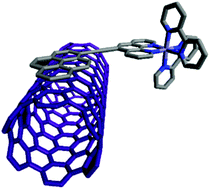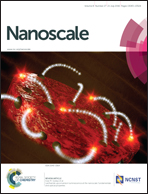Carbon nanotubes dispersed in aqueous solution by ruthenium(ii) polypyridyl complexes†
Abstract
Cationic ruthenium(II) polypyridyl complexes with appended pyrene groups have been synthesized and used to disperse single-walled carbon nanotubes (SWCNT) in aqueous solutions. To this end, planar pyrene groups enable association by means of π-stacking onto carbon nanotubes and, in turn, the attachment of the cationic ruthenium complexes. Importantly, the ionic nature of the ruthenium complexes allows the formation of stable dispersions featuring individualized SWCNTs in water as confirmed in a number of spectroscopic and microscopic assays. In addition, steady-state photoluminescence spectroscopy was used to probe the excited state interactions between the ruthenium complexes and SWCNTs. These studies show that the photoluminescence of both, that is, of the ruthenium complexes and of SWCNTs, are quenched when they interact with each other. Pump-probe transient absorption experiments were performed to shed light onto the nature of the photoluminescence quenching, showing carbon nanotube-based bands with picosecond lifetimes, but no new bands which could be unambigously assigned to photoinduced charge transfer process. Thus, from the spectroscopic data, we conclude that quenching of the photoluminescence of the ruthenium complexes is due to energy transfer to proximal SWCNTs.



 Please wait while we load your content...
Please wait while we load your content...